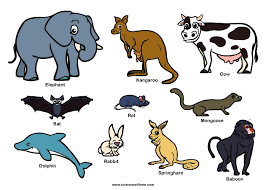Mammals represent one of the most diverse and fascinating groups of animals on Earth, encompassing a wide range of species that exhibit remarkable adaptations and behaviors. This class of vertebrates is characterized by several defining features, the most prominent being the presence of mammary glands that produce milk for nourishing their young, which is a critical aspect of their reproductive strategy. Mammals are warm-blooded, or endothermic, allowing them to maintain a constant body temperature regardless of environmental conditions. This ability has enabled them to inhabit a variety of ecosystems, from the frigid polar regions to the scorching deserts and dense tropical forests. The evolutionary history of mammals dates back to the Mesozoic Era, with early mammals being small, nocturnal creatures that thrived in the shadows of dinosaurs. Over time, mammals diversified and evolved into the myriad forms we see today, ranging from tiny shrews to massive whales. One of the most striking features of mammals is their varied forms of locomotion, including running, flying, swimming, and even gliding. For instance, while terrestrial mammals like lions and elephants rely on powerful legs for movement, aquatic mammals like dolphins and whales have adapted their limbs into flippers, enabling them to navigate the ocean with grace and speed. Bats, the only true flying mammals, showcase another unique adaptation, possessing elongated fingers covered by a thin membrane that allows for agile flight. Social structures among mammals vary widely; some species, like wolves and elephants, live in complex social groups that rely on cooperation and communication, while others, such as many rodents and solitary big cats, lead more independent lives. The intelligence and social behavior of mammals are particularly notable in species like dolphins, which exhibit sophisticated communication and problem-solving skills, and primates, including humans, whose cognitive abilities have led to the development of culture and technology. Reproductive strategies among mammals also display significant diversity, with most giving birth to live young—a process that allows for greater parental investment. Some mammals, like kangaroos, are marsupials, which give birth to relatively undeveloped young that continue to grow in a pouch. Others, such as monotremes like the platypus and echidna, are unique as they lay eggs instead of giving birth to live young. The adaptations of mammals extend beyond their reproductive methods; they have developed various forms of feeding habits as well. Mammals can be herbivores, carnivores, or omnivores, each utilizing specialized teeth and digestive systems to process their food effectively. Herbivores like cows and deer have complex stomachs to break down tough plant material, while carnivores like wolves and lions have sharp teeth designed for tearing flesh. Omnivores, such as bears and humans, have versatile diets that allow them to exploit a wide range of food sources. The evolutionary pressures faced by mammals have led to the development of unique adaptations, such as camouflage, mimicking behaviors, and various forms of communication, including vocalizations, body language, and scent marking. Many mammals are also equipped with heightened senses that aid in survival; for instance, bats utilize echolocation to navigate and hunt in complete darkness, while elephants have an extraordinary sense of smell that helps them detect food and communicate over long distances. Unfortunately, many mammal species face significant threats due to human activities, including habitat destruction, climate change, and poaching. Conservation efforts are crucial to protect these remarkable animals and their habitats. Organizations around the world are working to establish protected areas, promote sustainable practices, and raise awareness about the importance of biodiversity. Public education plays a vital role in fostering appreciation for mammals and encouraging responsible behaviors that help conserve their populations. As we explore the incredible diversity of mammals, we uncover a world rich in complexity and interconnection. From the majestic blue whale, the largest animal on the planet, to the tiny bumblebee bat, the smallest mammal, these creatures share our world in ways that inspire awe and wonder. Understanding and appreciating the intricate relationships between mammals and their environments is essential for ensuring their survival for future generations. By supporting conservation efforts and promoting awareness, we can help protect these warm-blooded wonders and the ecosystems they inhabit.
